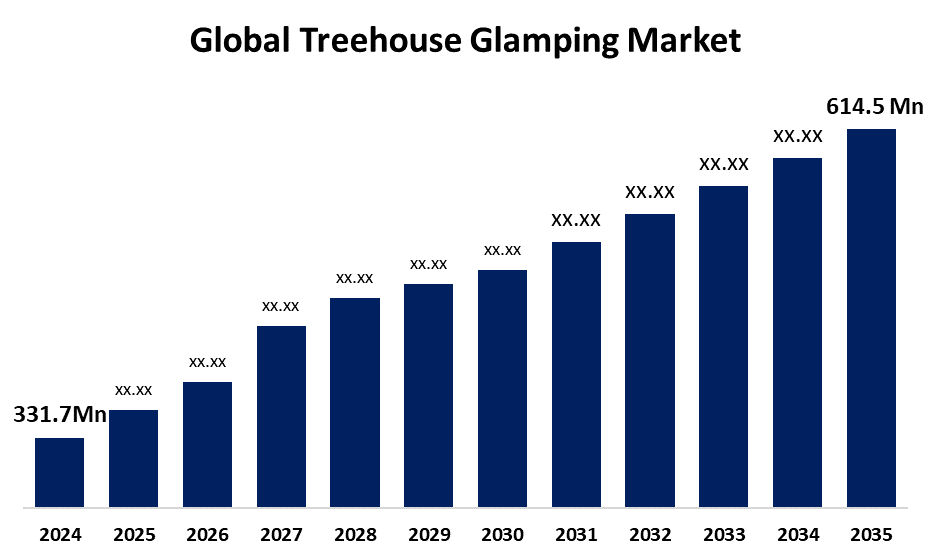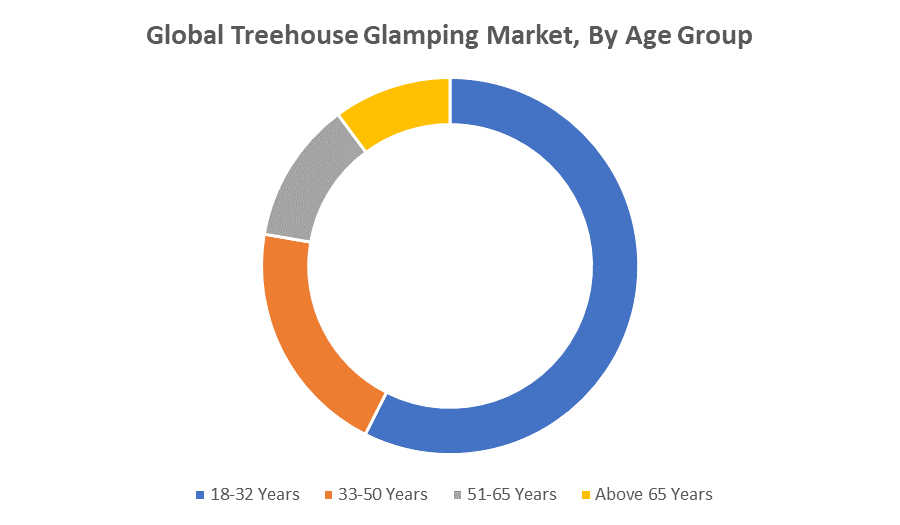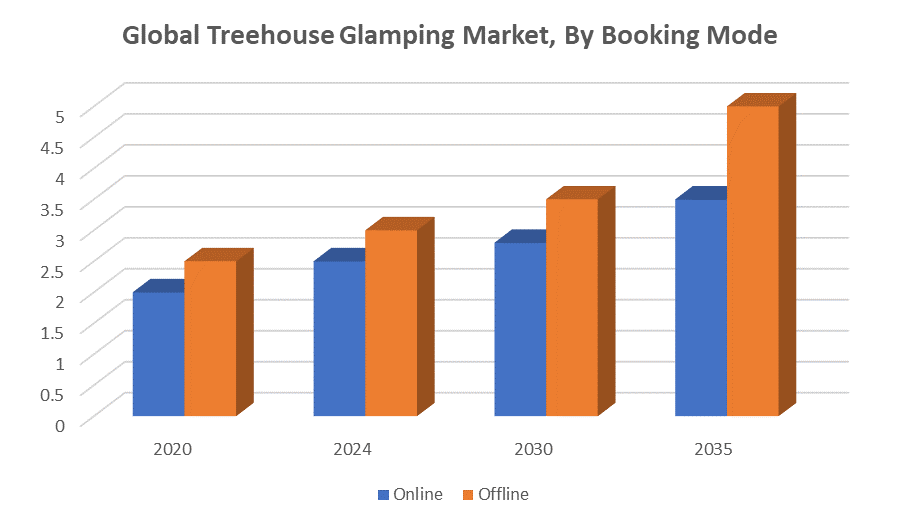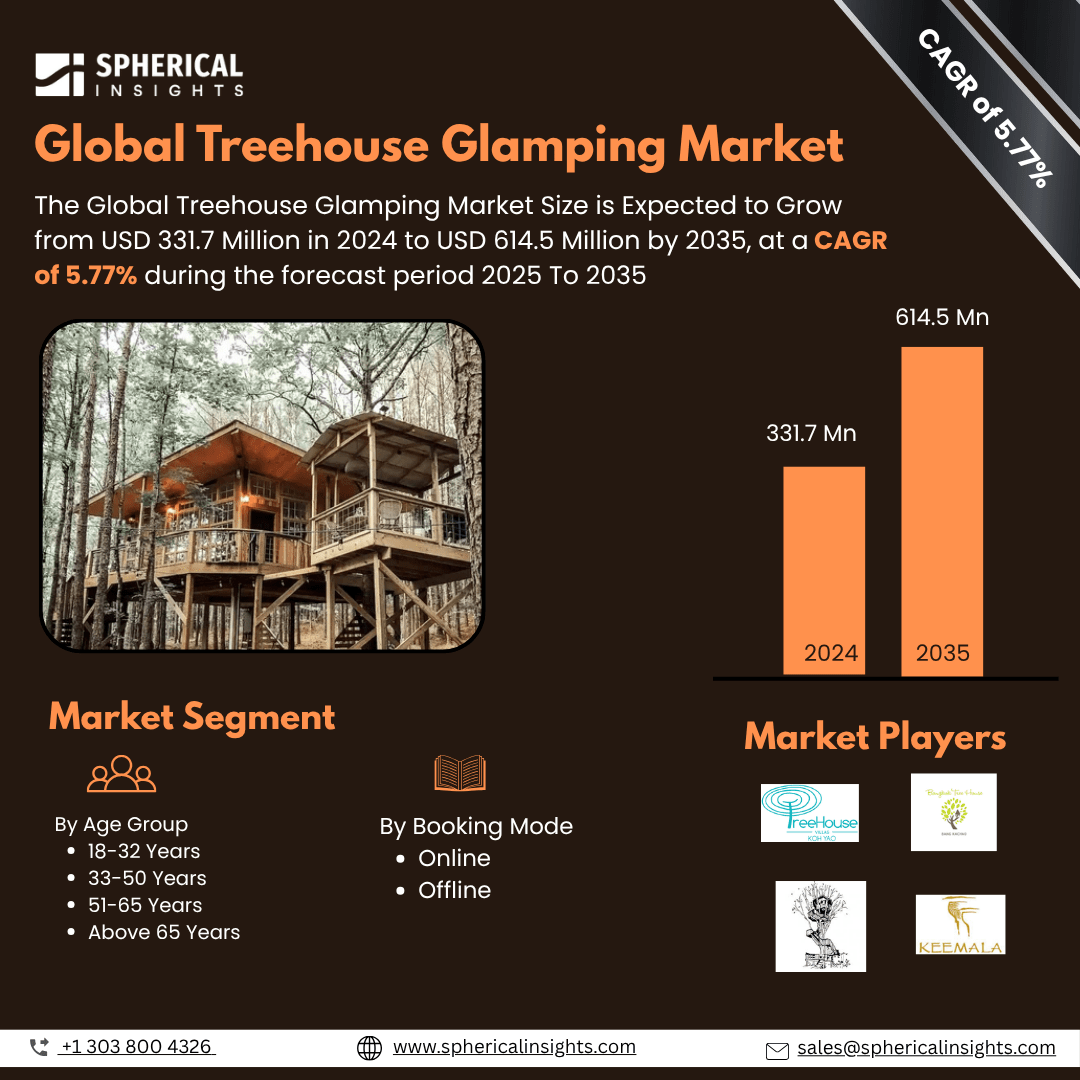Global Treehouse Glamping Market Insights Forecasts to 2035
- The Global Treehouse Glamping Market Size Was Estimated at USD 331.7 Million in 2024
- The Market Size is Expected to Grow at a CAGR of around 5.77% from 2025 to 2035
- The Worldwide Treehouse Glamping Market Size is Expected to Reach USD 614.5 Million by 2035
- Asia Pacific is expected to grow the fastest during the forecast period.

Treehouse Glamping Market
The global treehouse glamping market is a niche segment within the broader glamping industry, offering unique, elevated accommodations in forested or natural settings combined with modern comforts such as plush bedding, electricity, Wi Fi, and private bathrooms. This style of travel caters to consumers looking for immersive outdoor experiences without sacrificing luxury or convenience. Treehouse glamping appeals particularly to younger travelers who value memorable, Instagram worthy stays that blend sustainability with style. The market is characterized by a blend of hospitality, eco tourism, and adventure travel, attracting both solo adventurers and couples seeking romantic or wellness focused getaways. While the market continues to grow steadily, it remains highly experience driven, with design, setting, and amenities playing critical roles in consumer choice. Though many bookings still occur through traditional travel agents or direct contact with providers, online platforms and mobile apps are increasingly used. As travel trends evolve, treehouse glamping is positioned as a compelling alternative to conventional lodging.
Attractive Opportunities in the Treehouse Glamping Market
- Incorporating wellness programs such as yoga, meditation, and digital detox retreats can transform treehouse stays into holistic getaways, appealing to health conscious and wellness-seeking travelers.
- Collaborating with influencers and brands to create curated, social media driven experiences can attract niche audiences looking for unique, shareable travel moments.
- Utilizing scenic and remote treehouse locations for corporate events, weddings, and special occasions can open new revenue streams and boost occupancy beyond typical leisure travelers.
Global Treehouse Glamping Market Dynamics
DRIVER: Increasing consumer demand for unique and immersive travel experiences
Increasing consumer demand for unique and immersive travel experiences is a primary driver, as more travelers seek memorable stays that combine nature with comfort. The rise of eco tourism and sustainable travel also supports this trend, with treehouse accommodations often built using environmentally friendly materials and designed to blend into natural surroundings. Social media influence, especially among younger travelers, has amplified interest in visually appealing and unconventional lodging options like treehouses. Additionally, higher disposable incomes and greater emphasis on wellness and mental health have led people to prioritize leisure activities that offer relaxation and escape from daily routines. The hospitality industry’s growing investment in experiential offerings, along with the expansion of online booking platforms, has made treehouse glamping more accessible to a broader audience. Together, these factors are contributing to the steady rise of this unique and experience centric market segment.
RESTRAINT: High cost of building and maintaining treehouse structures
One major issue is the high cost of building and maintaining treehouse structures, which require special materials, engineering, and regular safety checks. These accommodations are also often seasonal, with fewer bookings during colder or rainy months, which affects year round profitability. In many areas, strict zoning laws and building regulations make it difficult to get the necessary permits for tree based structures. Additionally, treehouse glamping competes with other unique lodging options, such as cabins, tiny homes, and eco resorts, which may be easier to build or more affordable for travelers. These factors, including high setup costs, seasonal limitations, legal restrictions, and competition, can all act as barriers to growth in the market.
OPPORTUNITY: Integration of wellness and retreat-focused experiences
The treehouse glamping market presents several unique opportunities beyond general demand and eco-tourism trends. One promising area is the integration of wellness and retreat-focused experiences, such as yoga, meditation, and digital detox programs, which can transform treehouse stays into holistic getaways. There’s also strong potential in partnering with travel influencers and lifestyle brands to create curated, social media driven experiences that appeal to niche audiences. Expanding into corporate retreats, weddings, and event hosting offers additional revenue streams, especially in scenic or remote locations. Technological upgrades like smart lighting, off grid solar systems, and app based concierge services can also enhance guest satisfaction and attract tech savvy travelers. Furthermore, there is room for innovation in modular or prefabricated treehouse designs, which can reduce construction costs and environmental impact. These opportunities allow operators to diversify offerings, boost occupancy rates, and stand out in an increasingly competitive market focused on unique, meaningful, and personalized travel experiences.
CHALLENGES: Guests have a consistent and comfortable experience
One major issue is making sure guests have a consistent and comfortable experience, as weather, insects, or uneven terrain can affect their stay. Treehouses are often located in remote areas, which makes it harder to deliver supplies, provide quick customer service, or handle emergencies. Finding staff willing to work in these isolated places can also be difficult, especially when high service standards are expected. Another challenge is balancing luxury with eco-friendliness, offering modern comforts without harming the natural environment is not always easy. The market is also sensitive to outside factors like wildfires, storms, or global travel disruptions, which can lead to cancellations or lost revenue. These practical and environmental challenges make it important for treehouse glamping providers to plan carefully and stay flexible.
Global Treehouse Glamping Market Ecosystem Analysis
The global treehouse glamping market ecosystem includes accommodation providers, such as eco-resorts and boutique operators, collaborating with specialized construction and design firms focused on sustainable, tree-based structures. Technology vendors supply booking platforms, smart solutions, and renewable energy systems. Tourism boards and travel agencies help promote offerings, while influencers drive demand among millennials and eco-conscious travelers. Regulatory bodies and environmental experts ensure safety and sustainability. Together, these players create a connected network that delivers unique, nature based luxury experiences within a growing, eco friendly travel market.
Based on the age group, the 18 32 years age group accounted for the largest share and is expected to grow at a remarkable CAGR during the forecast period

The 18 32 years age group, comprising millennials and Gen Z, dominates the global treehouse glamping market due to their strong preference for unique, immersive travel experiences that blend adventure with comfort. Influenced heavily by social media, they are drawn to the visual appeal and shareability of treehouse stays set in natural environments. This demographic also values sustainability and eco friendly travel options, making treehouse glamping an ideal choice. With increasing disposable income and a focus on wellness and outdoor activities, this age group is expected to drive significant market growth at a remarkable CAGR during the forecast period.
Based on the booking mode, offline mode held the highest revenue share in the overall treehouse glamping industry during the forecast period

Offline booking mode has held the highest revenue share in the global treehouse glamping industry during the forecast period. Many travelers still prefer booking treehouse stays through direct contact with operators, travel agencies, or over the phone, valuing personalized service and trust in traditional methods. This is especially common in remote or less digitally connected locations where online infrastructure may be limited. Additionally, offline bookings often allow for customized arrangements and direct communication, which appeals to guests seeking unique or tailored experiences. However, as digital adoption grows, online booking platforms are gradually gaining traction, complementing the dominant offline market.
Europe is anticipated to hold the largest market share of the treehouse glamping market during the forecast period
Europe is anticipated to hold the largest market share of the treehouse glamping market during the forecast period due to its well-established tourism infrastructure and strong focus on sustainable and eco-friendly travel. The region’s diverse natural landscapes, including forests, mountains, and lakes, provide ideal locations for treehouse accommodations. Additionally, growing consumer awareness about environmental conservation and a high demand for unique, experiential stays further drive the market. Europe’s developed travel and hospitality sectors, along with supportive government policies promoting eco-tourism, also contribute to its leading position in the global treehouse glamping market.
Asia Pacific is expected to grow at the fastest CAGR in the treehouse glamping market during the forecast period
The Asia Pacific region is expected to grow at the fastest CAGR in the treehouse glamping market during the forecast period. This rapid growth is driven by rising disposable incomes, increasing domestic and international tourism, and a growing interest in unique and nature based travel experiences. Countries like India, Thailand, Indonesia, and Vietnam offer diverse natural landscapes that are ideal for treehouse accommodations. Additionally, expanding hospitality infrastructure, improving connectivity, and growing awareness of eco-tourism are fueling demand. The region’s young population, eager for adventurous and Instagram worthy stays, also contributes to the accelerating market growth.
Recent Development
- In October 2024, Treehouses.com LLC announced the 2024 World Treehouse Conference on 4,5, 6 October 2024. This conference was done with an objective to promote different commercial treehouse design and building of insightful and friendly structures aloft.
Key Market Players
KEY PLAYERS IN THE TREEHOUSE GLAMPING MARKET INCLUDE
- TreeHouse Villas Koh Yao
- Bangkok Tree House
- Rabeang Pasak Treehouse Resort
- Keemala
- Orion Tree Houses B B
- Nelson Tree House Supply
- Tree House Hideaway
- Costa Rica Tree House Lodge
- Pai Treehouse Resort
- Free Spirit Spheres
- Others
Market Segment
This study forecasts revenue at global, regional, and country levels from 2020 to 2035. Spherical Insights has segmented the treehouse glamping market based on the below-mentioned segments:
Global Treehouse Glamping Market, By Age Group
- 18 32 Years
- 33 50 Years
- 51 65 Years
- Above 65 Years
Global Treehouse Glamping Market, By Booking Mode
Global Treehouse Glamping Market, By Regional Analysis
- North America
- Europe
- Germany
- UK
- France
- Italy
- Spain
- Russia
- Rest of Europe
- Asia Pacific
- China
- Japan
- India
- South Korea
- Australia
- Rest of Asia Pacific
- South America
- Brazil
- Argentina
- Rest of South America
- Middle East & Africa
- UAE
- Saudi Arabia
- Qatar
- South Africa
- Rest of the Middle East Africa






